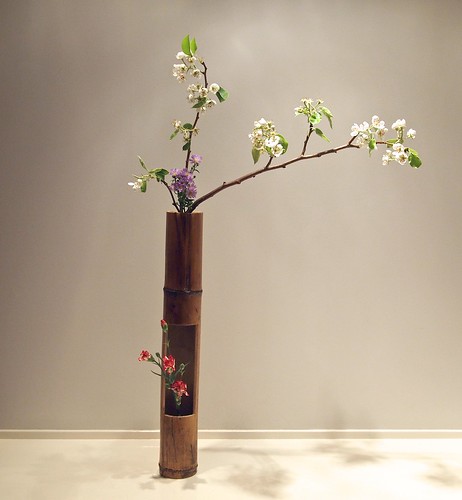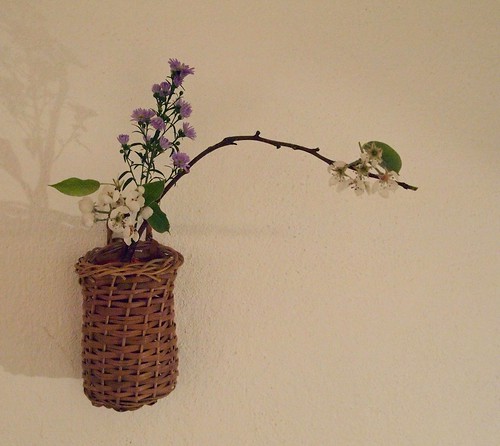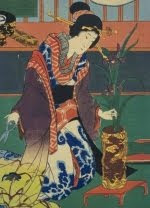Bamboo vase, Seika style.
Pear branches, Aster, Carnations.
Pear branches, Aster, Carnations.
Long overdue, I'm posting the last of this spring terms exercises with arrangements inspired by the traditional Seika style. I love bamboo vases, but unfortunately I don't have any like this at home, so this one is my teachers. Since bamboo vases crack easily from drying up or from the tension of komi sticks used to fix the flowers, it's best to have a bamboo tube with copper cups in the compartments to hold the water.
This kind of arrangement is called Niju-ike. Niju means double-level, and you'll need a tall bamboo tube converted into a two-level container for this style. The top holds the main arrangement with branches sweeping sideways. The smaller arrangement in the window further down on the vase usually holds seasonal cut flowers. I've made this group also a little bit tilting to balance the branches at the top, but it can also be made in a straighter form that remains totally inside the window. This will give a very peaceful result. Niju-ike is a much loved old poetic style depicting a grand view of the nature, with the beaches of an old tree on a cliff sweeping over a valley with humble flowers.
This second arrangement is a Seika style made to hang on a wall. Kakebana is a word used for all arrangements hanging from a wall. This kind of Seika is usually a small and quite informal arrangement. As with all Seika arrangements it's important that the three branches are very clean at the base and placed together so as to look like one stem coming up from the vase.
This kind of arrangement is called Niju-ike. Niju means double-level, and you'll need a tall bamboo tube converted into a two-level container for this style. The top holds the main arrangement with branches sweeping sideways. The smaller arrangement in the window further down on the vase usually holds seasonal cut flowers. I've made this group also a little bit tilting to balance the branches at the top, but it can also be made in a straighter form that remains totally inside the window. This will give a very peaceful result. Niju-ike is a much loved old poetic style depicting a grand view of the nature, with the beaches of an old tree on a cliff sweeping over a valley with humble flowers.
Kakebana, Seika style.
Pear blossoms and Aster.
Pear blossoms and Aster.
This second arrangement is a Seika style made to hang on a wall. Kakebana is a word used for all arrangements hanging from a wall. This kind of Seika is usually a small and quite informal arrangement. As with all Seika arrangements it's important that the three branches are very clean at the base and placed together so as to look like one stem coming up from the vase.














No comments:
Post a Comment